Scotland
Journey Through Time: Castles, Kilts & Gaelic Charm
Scotland, a land of rugged landscapes and timeless legends, where ancient castles overlook misty lochs and the haunting strains of bagpipes echo through history offers a journey that weaves through iconic cities, mysterious lochs, and enchanting highlands. Experience Scotland's history and enjoy the charm and warm hospitality of its friendly citizens.
Edinburgh: A Journey Through Time
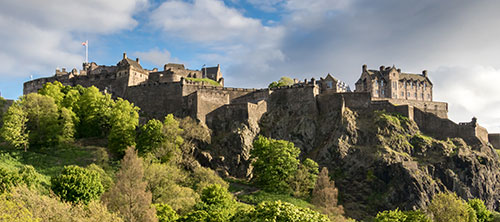
L. Galbraith / Adobe Stock |
| Begin your Scottish adventure in the capital city, Edinburgh. Be transported to a bygone era as you stroll through its historic streets. Take a guided tour of the magnificent Edinburgh Castle, perched atop a volcanic rock, and immerse yourself in Scotland's royal past. See the Crown Jewels of Scotland in Edinburgh Castle. They are among the most famous and historically significant artifacts in Scotland. |
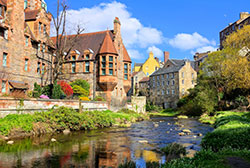
Photo by Jenifoto / Adobe Stock |
Just a short walk from the city center, you can wander along cobblestone streets of historic Dean Village, a charming, scenic former milling village set along the Water of Leith pictured here. Also nearby is the Scottish National Gallery of Modern Art, a short 15 minute walk from Dean Village, where you can immerse yourself in a world of contemporary artistic expression. |
Dive deeper into the nation's heritage at the National Museum of Scotland, a treasure trove of artifacts and knowledge. Wander down the Royal Mile, where centuries of history unravel in the form of charming shops, restaurants, and pubs.
For a true taste of Scotland, dine in the Old Town and savor traditional dishes. If you're visiting in August, the Edinburgh Festival Fringe beckons with a whirlwind of arts and culture. This world-renowned event showcases an array of performances, from theater to comedy, making it an unforgettable addition to your Scottish itinerary.
|
Glasgow: Where History Meets Contemporary Splendor
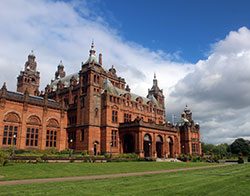
Calum Smith / Adobe Stock |
A short journey from Edinburgh lies Glasgow, Scotland's largest city, replete with fascinating cultural attractions. Explore the Kelvingrove Art Gallery and Museum, where an extensive collection awaits art enthusiasts. Nearby, the stunning Glasgow Cathedral beckons, its Gothic architecture and history echoing through the centuries. |
| The Riverside Museum offers a glimpse into the city's transport history, while the People's Palace narrates the stories of Glasgow's working class, providing insight into the city's cultural heritage. With a blend of history and modernity, Glasgow will captivate your heart. |
Loch Ness: The Enigma Unveiled
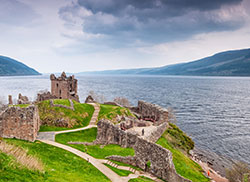
Photo by Horváth Botond / Adobe Stock |
Take a journey to Loch Ness, home of the elusive Nessie, which some believe to be a plesiosaur, a long-necked aquatic dinosaur that went extinct over 66 million years ago. Explore the hauntingly beautiful Urquhart Castle, its ruins overlooking the mysterious waters. Hop on a boat cruise and enjoy the breathtaking scenery. Gain a deeper understanding of this enigmatic loch at the Loch Ness Centre. |
Inverness: Castles, Battlefields, and Culture
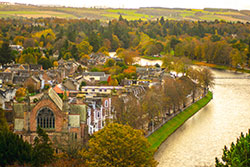
Photo by Catalin / Adobe Stock |
Inverness, the heart of the Highlands, is a treasure trove of historical sites and cultural experiences. Visit Inverness Castle, a former Clan Fraser stronghold, and marvel at the panoramic views of the city. For a glimpse into Scotland's tumultuous past, embark on a day trip to the Culloden Battlefield, the site of the last pitched battle in British history. |
|
Explore the enchanting Cawdor Castle, rumored to have inspired Shakespeare's Macbeth. To unwind, take a boat trip on the picturesque River Ness or enjoy a show at the Eden Court Theatre, the largest theatre in the Highlands.
|
Scottish Highlands: Nature's Majesty Unleashed

By EyesTravelling / Adobe Stock | Finally, venture into the untamed beauty of the Scottish Highlands. Cairngorms National Park offers hikers and nature enthusiasts boundless opportunities to reconnect with the great outdoors. For an awe-inspiring experience, trek through Glen Etive, a valley surrounded by majestic mountains and cascading waterfalls. |
|
Glencoe's scenic grandeur will leave you breathless, and Eilean Donan Castle, nestled on a small island in Loch Duich, is an architectural gem worth exploring. Lastly, set your sights on the Isle of Skye, where dramatic landscapes, ancient castles, and charming villages create a visual symphony that you won't soon forget.
|
With its rich history, stunning landscapes, and welcoming culture, Scotland invites travelers over 50 to embark on an unforgettable journey through time and nature. So pack your bags, for the spirit of Scotland awaits, promising a rejuvenating and inspiring adventure for all ages.
Best Time to Visit:
The best time to visit Scotland depends on your personal preferences and the specific experiences you seek. Here is a breakdown of the seasons and what they offer:
Spring (March to May): Average Temperatures: 45-55°F (7-13°C)
Spring in Scotland brings milder temperatures, blooming flowers, and longer daylight hours. It's an excellent time to visit if you enjoy exploring cities like Edinburgh and Glasgow, as the weather is pleasant for walking tours and outdoor activities. You can also witness the stunning Scottish landscapes coming to life and enjoy cultural events.
Summer (June to August): Average Temperatures: 60-65°F (15-18°C)
Summer is a popular time to visit Scotland, especially for outdoor activities and festivals. The weather is generally warm, and you can explore the country's iconic landscapes, including the Highlands and islands. Cities like Edinburgh host the famous Edinburgh Festival, attracting artists and visitors from around the world. However, it can be crowded, particularly in tourist hotspots.
Autumn (September to November): Average Temperatures: 50-55°F (10-13°C)
Autumn in Scotland is characterized by mild temperatures, colorful foliage, and fewer crowds compared to the summer months. It's an ideal time for hiking, touring historic sites, and enjoying the beautiful autumn scenery. The country's whiskey distilleries and local festivals also come alive during this season.
Winter (December to February): Average Temperatures: 35-45°F (2-7°C)
Scotland's winter offers a festive atmosphere with Christmas markets, mulled wine, and holiday decorations. If you enjoy winter sports like skiing or snowboarding, the Scottish mountains and resorts provide excellent opportunities. Cities like Edinburgh and Inverness have their own unique winter charm with cozy pubs and cultural events.
Travel Planning Tips:
Plan Ahead: Before your trip, research the cities, regions, and attractions you wish to visit. Make a list of must-see places and plan your itinerary accordingly. This will help you make the most of your time and ensure you don't miss out on any key experiences.
Cash and Currency: Scotland's currency is the British Pound (£). Inform your bank about your travel plans to avoid any issues with your cards. While major cities accept card payments, it's a good idea to carry some cash, especially in rural areas where not all places may accept cards. Tipping is not as customary as in the United States, but it is appreciated in restaurants and for services such as taxis.
Travel Insurance: Ensure that you have comprehensive travel insurance that covers medical expenses, trip cancellation, and any potential emergencies. Review the policy details and know how to access medical assistance if needed.
Check Visa Requirements: Depending on your nationality, you may need a visa to enter Scotland. Check the visa requirements well in advance and apply if necessary. Ensure that your passport is valid for at least six months beyond your planned departure date.
Pack Accordingly: Scotland's weather can be unpredictable. Pack clothing suitable for the season of your visit, and be prepared for occasional rain. Don't forget to include comfortable walking shoes, as exploring cities and natural landscapes often involves walking. Consider bringing a universal power adapter for charging your electronic devices.
Accommodations:
Hotels: Scotland offers a diverse range of hotels, from luxurious establishments to more budget-friendly options. Many hotels provide accessibility features, such as elevators and accessible rooms, to cater to travelers with specific needs. It's advisable to inquire about senior discounts, as some hotels may offer special rates for retirees.
Guesthouses and Bed & Breakfasts: Guesthouses and B&Bs provide a cozy and often more intimate experience. These accommodations are typically run by local hosts who offer personalized service and a homely atmosphere. Retirees who enjoy interacting with locals and experiencing authentic hospitality often find these options appealing.
Spa and Wellness Resorts: Scotland is renowned for its spa and wellness offerings, with numerous wellness retreats that provide rejuvenating treatments, thermal baths, and relaxation facilities. Retirees looking for relaxation and wellness-focused experiences can choose from a variety of spa retreats located in picturesque regions such as the Scottish Highlands or the Isle of Skye.
Transportation:
Scotland offers a well-developed transportation network, making it convenient to explore the country. Here are some transportation tips for your visit:
Domestic Flights: While trains and buses are primary modes of travel, domestic flights are available within Scotland. Airlines like Loganair operate regional routes, connecting major cities and remote areas, especially in the Scottish Highlands and Islands. Flying can be a time-efficient option for covering longer distances, but it may not always be the most cost-effective choice for shorter journeys.
Trains: Scotland's rail network is operated by ScotRail and covers major cities as well as scenic routes through the countryside. Trains are a popular and efficient mode of transportation. Consider booking tickets in advance, especially for long-distance or high-speed trains. The ScotRail Spirit of Scotland Pass offers flexibility for travelers planning to explore multiple destinations.
Buses: Scotland has an extensive network of buses, including city buses and long-distance coaches. Companies like Stagecoach and Citylink operate routes connecting various cities and towns. Buses can be a budget-friendly and flexible option for reaching destinations that might not be directly accessible by train.
Rental Cars: If you prefer flexibility and want to explore remote or rural areas, renting a car is an option. Scotland has well-maintained road networks, including scenic routes like the North Coast 500. Make sure to familiarize yourself with local traffic rules and parking regulations. Keep in mind they drive on the left side of the road in Scotland and the UK, so if you aren't comfortable with that, consider taking other modes of transportation. Also, cars have the steering wheel on the right side so you may need to adjust to this. Booking a rental car in advance is recommended, and check for any specific requirements, such as an International Driving Permit.
Taxis: Taxis in Scotland are generally safe and reliable. It's advisable to use licensed taxis, which are marked and metered. Taxi fares are calculated based on distance and may include additional charges for luggage or nighttime rides. Taxis usually accept both cash and credit cards. Tipping taxi drivers is customary, with rounding up the fare or giving a small additional amount as a gesture of appreciation.
Public Transportation:
Scotland's cities have excellent public transportation systems, including buses, trams, and in some cases, underground or subway trains. Each city has its own ticketing system, which can usually be purchased at ticket machines or on board. Consider purchasing day passes or multi-day passes for unlimited travel within a specific city. Edinburgh has a small underground rail system, known as the Edinburgh Subway, which has two lines. Check out the Transport for Edinburg web site to learn more.
Safety Tips:
- Stay Aware of Your Surroundings: While Scotland is generally safe, it's important to remain aware of your surroundings, especially in crowded areas or tourist spots. Keep an eye on your belongings and avoid displaying valuable items in public. Be vigilant with your bags, especially in busy transportation hubs or when using public transportation.
- Use Reliable Transportation: Opt for licensed taxis, official transportation services, or reputable ride-hailing apps when getting around. If you're using public transportation, be mindful of your belongings and be aware of any announcements or safety guidelines provided.
- Secure Your Accommodation: Choose reputable accommodations and ensure that your room has proper security measures. Use safes or lockers for storing valuable items. Keep your room locked when you're not present, and use extra caution if you're staying in shared accommodations.
- Be Cautious of Scams: While is Scotland is generally safe, be aware of common scams that can target tourists. Exercise caution when approached by strangers offering unsolicited help, as they may have ulterior motives. Be skeptical of overly friendly individuals or situations that seem suspicious.
- Health and Hygiene: Scotland maintains good health and hygiene standards. However, it's always wise to carry a basic first aid kit with essential medications and any necessary prescriptions. Maintain good hand hygiene and follow any health guidelines or advisories provided during your visit.
- Emergency Contacts: Familiarize yourself with the local emergency contact numbers in Scotland, such as 999 for police assistance and 112 for medical emergencies. Keep important contact numbers, including your embassy or consulate, stored in your phone or written down.
- Travel Advisories Stay updated on current events, local regulations, and any travel advisories when traveling abroad. Visit the US Government State Department Travel Advisories web site to check on the status of your destination.
- Enroll in the STEP Program: Travelers are also urged to enroll in the U.S. State Department's Smart Traveler Enrollment Program (STEP) to receive security messages and to make it easier to locate them in an emergency. The Department uses these security messages to convey information about terrorist threats, security incidents, planned demonstrations, natural disasters, etc. In an emergency, please contact the nearest U.S. Embassy or consulate or call the following numbers: 1 (888) 407-4747 (toll-free in the United States and Canada) or 1 (202) 501-4444 from other countries.
| |
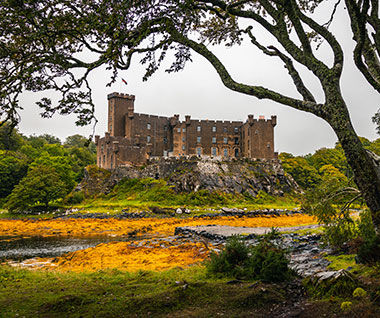 Dunvegan Castle, Isle of Skye Photo by Ondej / Adobe Stock
 Edinburgh
Photo by Stefan / Pixabay
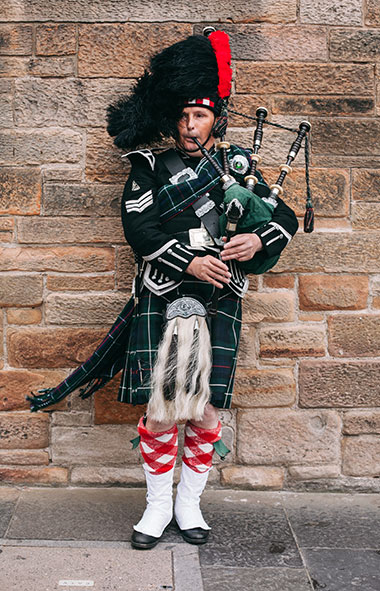 Man playing bagpipes
Photo by Andrei I / Pexels
|
 Dunvegan Castle, Isle of Skye
Dunvegan Castle, Isle of Skye Edinburgh
Edinburgh Man playing bagpipes
Man playing bagpipes

